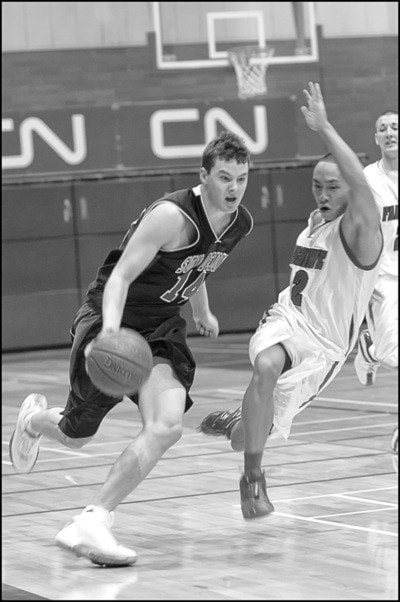I will start by admitting that I am not a sports photographer even though during my years as photographer for the University College of the Cariboo I produced many images of basketball, soccer and hockey games for their publications, etc.
When I first started working in the unfamiliar campus locations, under inconsistent lighting and with fast moving subjects, I quickly realized that I needed more than just an understanding of photography basics. I needed to know what viewers of the sporting events were looking for. At the time the internet wasn’t as effective to search for answers and photography magazines appeared useless with publications that were more geared in selling products than giving usable instruction.
The best education I could get was by looking through magazines like Sports Illustrated and trying to figure out how the photographs that I saw were made. I think that is still a great way to learn, certainly not the only way, but helpful all the same.
This last week an aspiring (and struggling) sports photographer showed me his most recent images. He has lots and lots of fun shots, but I could see he needed to study hard if his images were to move from stiff, point and shoot, machine gun style photographs to those that visually talk about athletes and the energy of the sport.
Photographer Jerry Lodriguss (http://www.astropix.com/SPORTSPIX/NSC/NOTES.HTM) writes in his tips on sports photography, “Sports photography is one of the few remaining pure forms of documentary photography. The moment happens and it is gone. You either capture it in an image or you don’t.”
My approach to photographing sports is to select a shooting position, a subject to watch and work from there until I had what I wanted. Then I would move position, change the subject and start again. I wondered if professional sports photographers would give that approach much credence, but Lodriguss made me feel better when he wrote, “Don’t think that your shooting position will somehow stop you from getting photos. Good pictures happen at every focal length and location. You just have to be ready to take them when they do.”
Anyway, that was pretty much my approach and it worked well for me and gave my employer lots of usable images.
I would begin by studying the light across the field or court, so I could make a good exposure when my subjects moved there. I selected the highest shutterspeed and shot in the Shutter priority mode. My choice of equipment in the beginning were fixed focal lengths or in modern jargon, “prime”. But today I’d use a fast focusing vibration reducing lens like my 70-210mm.
Advice on equipment by Mr. Lodriguss is, “Photography is not totally about equipment, although having the right equipment can be important at the highest levels of sports photography. Photography is really about seeing, and light, and composition, and most importantly, content. Only gearheads and equipment freaks care more about what camera was used to take a picture than about the content and aesthetics of the image itself. No one cares what typewriter Hemingway used to write with. Mastering your equipment is just a first step in mastering your craft.”
But he also wrote about the little point-and-shoot cameras, “The snapshot type cameras are usually difficult to use for sports photography because of the time lag while the camera focuses and the shutter opens. It is tough to shoot peak sports action with these cameras. On some you may be able to pre-focus on where you expect the action to happen, and then ride the shutter button so that the shutter will open in a reasonable amount of time after you press it. Most of these cameras are also not very good under low light conditions because they have very small pixels which cannot collect a lot of light and consequently suffer from high noise.”
I think those sports photographers that are the most successful know the game they photograph well and in many cases are able to anticipate the fast changing action of a particular athlete and I mentioned that during my conversation. I also suggested to the aspiring photographers and suggest to my readers go online and check out Jerry Lodriguss’ sports tips page at http://astropix.com/SPORTSPIX/NSC/TIPS04.HTM.
These are my thoughts this week. Contact me at www.enmanscamera.com or email to: emcam@telus.net. Stop by Enman’s Camera at 423 Tranquille Road in Kamloops. And if you want an experienced photographer please call me. I also sell an interesting selection of used photographic equipment.
